7 Best Saltwater Fishing Rigs For Beginners (Setup Guide)
PUBLISHED 6 SEPTEMBER 2023
by Robert Ceran
Are you a novice angler planning to go saltwater fishing, but aren’t sure which fishing rig is best for your purposes?
Fishing in the ocean tends to be more complex than freshwater fishing, which is why it’s essential to use the right setup to get the best results.
In this article I’ll walk you through the best saltwater fishing rigs for beginners, and will also cover how to fish them, and how to choose the ideal setup for your purposes.
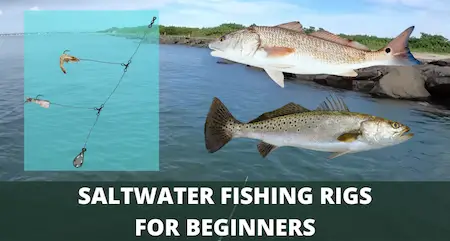
What are the best saltwater fishing rigs for beginners?
The 7 best saltwater fishing rigs for beginners are:
- Jig rig
- Carolina rig
- Knocker rig
- Fish finder rig
- 3 way swivel rig
- Double drop bottom rig
- Popping cork rig
We’ll go over the strengths and weaknesses of each of these saltwater fishing rigs below, so you can decide which one is best for you.
We’ll also cover the saltwater rigging basics that you need in order to use these setups.
Jig rig
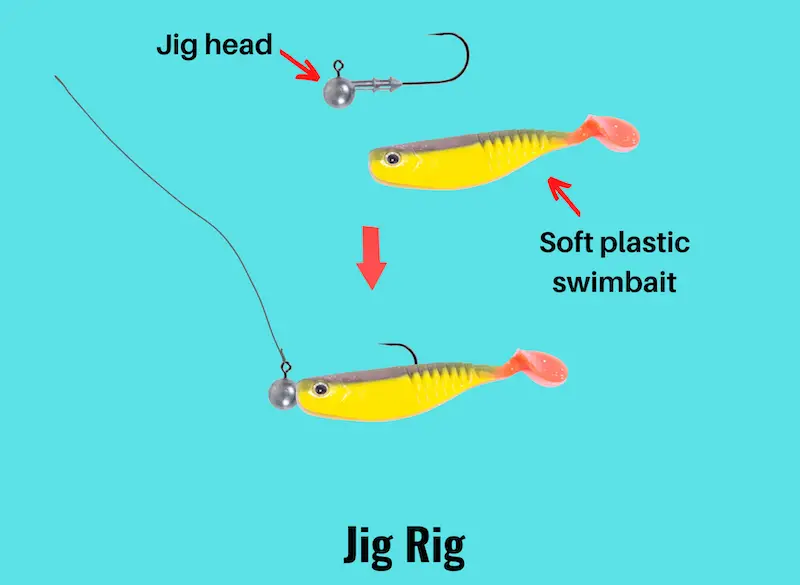
The jig rig is one of the simplest lure fishing rigs available to saltwater anglers, but at the same time one of the deadliest, which makes it an ideal setup for beginners.
In its basic form, the jig rig consists of a jig head tied to the end of the fishing line, as well as a soft plastic swimbait threaded onto the hook (see image above).
This saltwater rig setup only requires tying a single knot, baiting the hook, and presto – you’re ready to start fishing.
And while it’s not essential to use a leader with this rig, this can be helpful if you’re using a braided mainline, as that has quite a high visibility in the water.
In that case I recommend tying a mono or fluoro leader and attaching it to the mainline with a swivel.
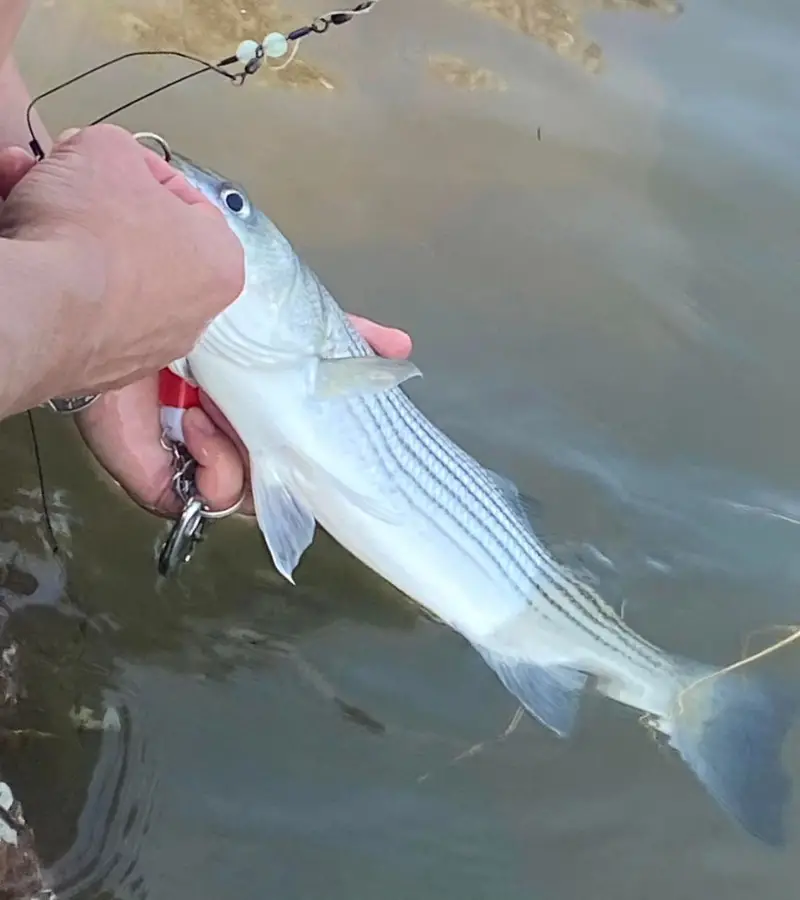
Image source: instagram/@kristaonthemountain
In order to fish this rig, cast it out, let it sink to the bottom, and then retrieve it with regular jerks and pauses.
It’s best to fish the jig rig around rocks and other structures (while being careful to avoid snags), as this is where predatory fish like to ambush their prey, and the swimbait mimics a wounded baitfish promising an easy snack.
In my experience the humble jig rig catches the majority of inshore saltwater species, including red drum, rockfish, speckled trout, flounder, spanish mackerel, bluefish, snook, and tarpon.
Another great thing about this setup is that you can use it from shore, or from a boat or kayak, and it’s my go-to lure fishing rig for fishing from piers, jetties, and rocks.
Saltwater Carolina rig
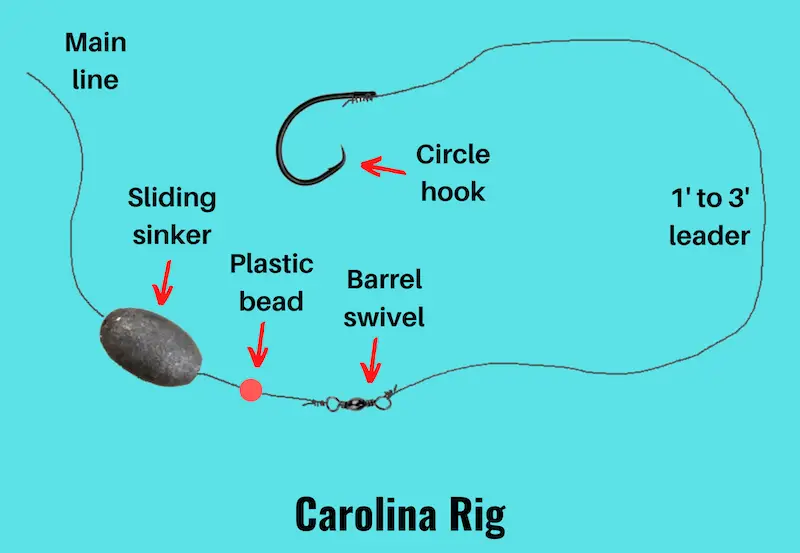
While the Carolina rig was originally developed for freshwater bass fishing, it also works like gangbusters for saltwater fishing, which explains why it’s one of the most popular inshore fishing rigs.
The Carolina rig consists of a sliding egg sinker that rides on the main fishing line (that goes to your fishing reel), as well as a barrel swivel connecting the mainline to a monofilament or fluorocarbon leader tied to a 2/0 to 4/0 circle hook or worm hook.
I like to use braided fishing line as my mainline, but monofilament also works well for this purpose, and is cheaper. If you like, you can also thread a 10mm plastic bead onto the line between the sinker and the swivel, which helps to protect the knot on the swivel.
The great thing about this bottom fishing setup is that you can use it equally well for fishing artificial lures or natural bait, and either retrieve your bait actively, or simply bait and wait.
Another key strength of the Carolina bottom rig is that the sliding sinker allows a fish to grab your bait and swim with it without feeling resistance from the weight, which enables you to set the hook before it spits out the bait.
The main disadvantage of the Carolina rig is that the leader tends to get tangled up with the mainline if you try to cast it very far, or if you drop it down very fast from a boat.
If this happens to you a lot, the knocker rig is a better alternative, which we’ll look at in full detail below.
Knocker rig
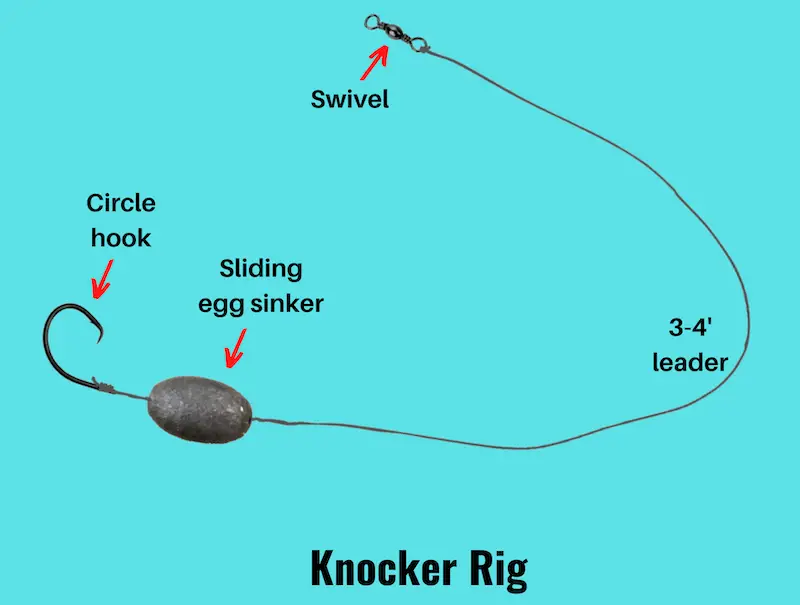
The knocker fishing rig has a similar overall structure to the Carolina rig, but with one key difference: the sliding sinker rides on the leader line, and not the mainline. This means it slides all the way down onto the hook.
While this seems to be a somewhat counterintuitive rig structure, it comes with one key advantage: the leader line and hook doesn’t get tangled up with your mainline when you cast it, or when you lower it down over the side of a boat for deep sea fishing.
In fact, if you’re planning to fish with cut bait, either from the beach or from a boat, I highly recommend using this rig, as there’s not much that can go wrong with it.
Since the knocker rig is much less prone to getting tangled during the casting process, this makes it an ideal surf fishing rig for beginners.
Overall, the ease of setup, ease of use, and effectiveness in catching the majority of saltwater fish make the knocker rig one of the very best saltwater rigs for beginners.
Saltwater fish finder rig
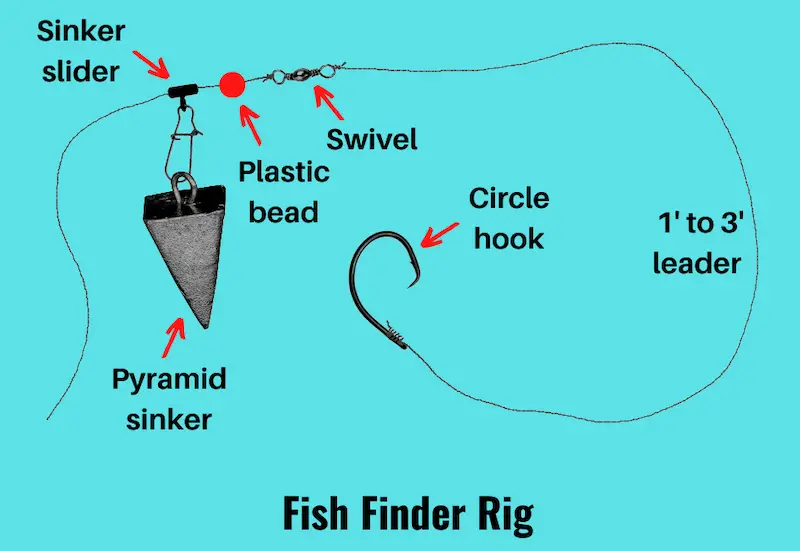
The fish finder rig is another great saltwater bottom fishing setup for beginners.
This rig is ideal for beach fishing or surf fishing, and is usually baited with freshly cut fish, chunks of shrimp, squid strips, or sand fleas.
It has a similar basic structure to the Carolina rig, but the main difference is that instead of an egg sinker it is made with a pyramid sinker that rides on the mainline with a sinker slide.
The fish finder rig consists of a heavy (1 to 6 ounce) pyramid weight attached to a sinker slide which rides on the mainline, as well as a barrel swivel that connects the mainline to a 2 to 3 foot monofilament leader with a circle hook.
The advantage of using a pyramid sinker is that it digs into a sandy bottom, and this helps to keep the rig in place when there is a strong swell or current.
The saltwater fish finder rig catches a wide variety of surf species, including redfish, whiting, black drum, fluke, flounder, sheepshead or striped bass.
Three-way swivel rig
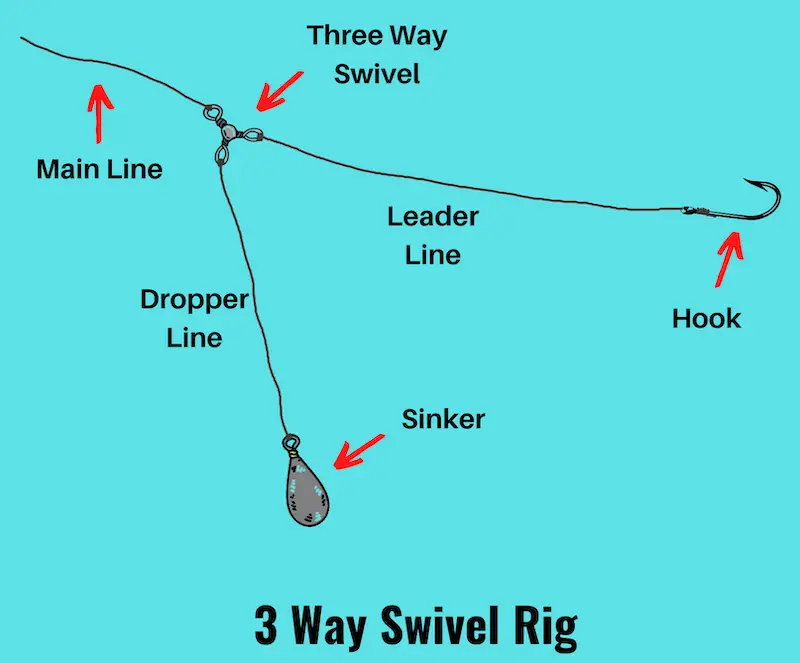
The 3 way swivel rig is a great all around bottom fishing rig that is very beginner friendly, as it is easy to tie.
It consists of a bank sinker or similar weight tied to the end of the fishing line, as well as a single hook attached to the line above the sinker with a three-way swivel (see image above).
You can tie this rig by using your favorite knot for attaching fishing line to an eye (I suggest either the uni knot or palomar knot), and you can use the same knot for attaching the sinker, the 3 way swivel, and the hook.
The line going from the 3 way swivel to the bank sinker is called a dropper line, and this should be weaker than your mainline. That way, if the sinker gets snagged on a rock, you can break it off without losing the rest of your terminal tackle.
The three way swivel fishing rig is great for fishing with live bait, or for fishing with freshly cut chunks of fish or squid, and catches a wide range of species that feed near the bottom, including groupers and snappers.
Double drop bottom rig
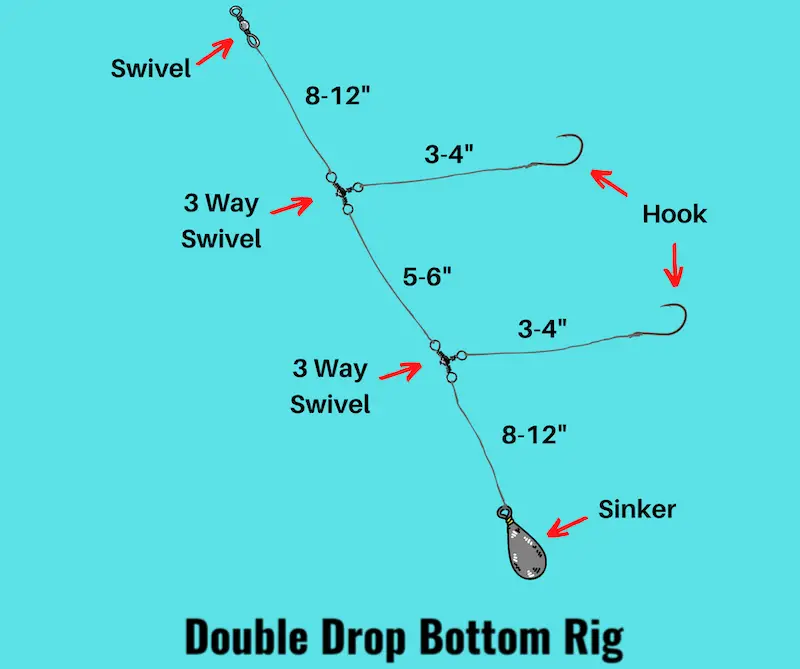
The double drop bottom rig is a great two-hook bottom fishing rig for beginners. It has the same overall structure as the 3-way swivel rig, but instead of a single hook, it has two hooks, which increases your odds of catching fish.
This setup is easy to tie, and the 3 way swivels come with the advantage that they help to keep the snoods of the hooks away from the leader line, which helps to reduce the chance of line tangles.
You can cast this two hook bottom rig out from the shore, or you can fish it vertically from a boat or a pier. Another advantage of using two hooks is that you can test two different baits at the same time.
Popping cork rig
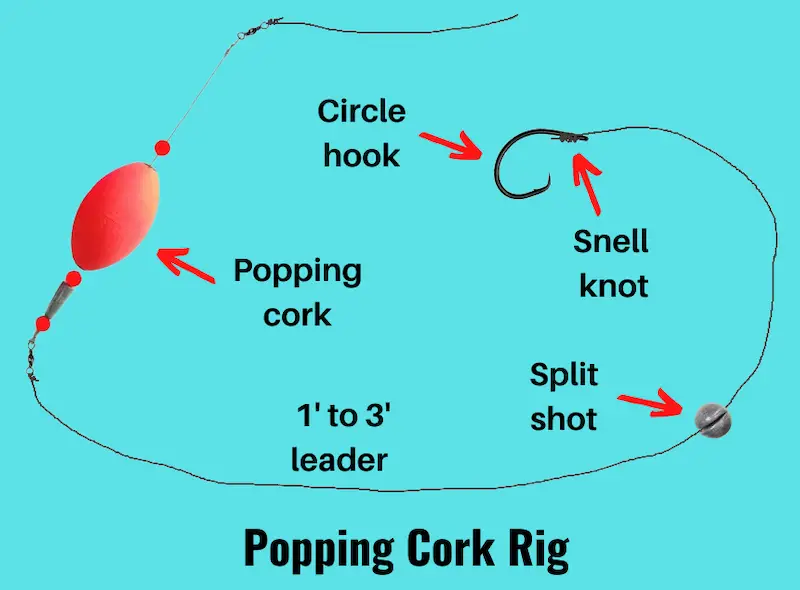
If you like bobber fishing, then the saltwater popping cork rig is ideal for you. This is a fixed bobber rig for inshore fishing in the shallow waters of creeks, estuaries, and mud flats.
It consists of a popping cork that’s tied to your main line at one end, as well as a 1 to 4 foot long leader tied to the other end.
The leader line is tied to an octopus hook or circle hook with a uni knot or snell knot, and one or more split shot weights are added to the leader line a few inches next to the hook, which helps to keep your bait close to the bottom.
The advantage of the popping cork is that it’s easy and fun for beginners to fish, and that it makes a rattling or popping sound when you jerk it with your rod, which helps to attract fish to come closer and investigate.
The popping cork rig can be fished with cut bait or pieces of shrimp, but the most effective way to use this setup is with live shrimp or live baitfish.
In order to fish this rig, bait the hook and cast it out to the edges of creeks or shellfish beds. If you don’t get a bite, retrieve it a foot or two and wait for a while, then repeat.
The popping cork rig is great for fishing in shallow waters up to 5 feet, and works best for red drum and speckled trout, though you can also catch other inshore species on this setup.
The main disadvantage of the popping cork is that it is a fixed bobber setup, which means you can’t use it in deep water. If you want to fish a bobber in water deeper than 5 feet, a slip bobber rig is a better option to go for.
